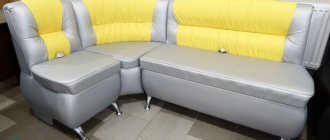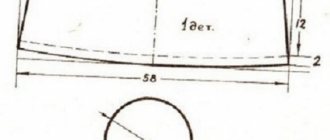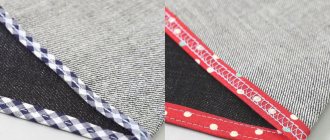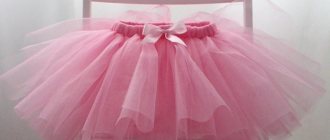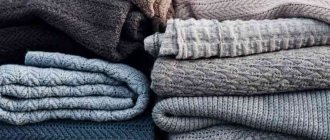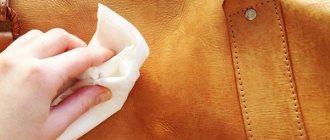Meaning of the noun in question
Before you find out how to write correctly: dermatin or dermantin, it is worth clarifying the meaning of this term.
This noun is the name of one of the many modern leather substitutes. This material is made by applying a nitrocellulose coating to a cotton backing.
This substance is also called “granitol” or “nitro artificial leather” (short for “nitrocellulose artificial leather”).
The widespread use of this substance began in the USSR in the thirties of the twentieth century. Despite the fact that granitol was seriously inferior in properties to natural leather, it was cheaper and easier to manufacture, and still surpassed ordinary fabric in many respects.
Until the fifties (when nitro artificial leather was forced to give up part of the market to more wear-resistant and durable materials), granite was actively used for upholstery of furniture and doors, making haberdashery, and even for binding books.
In later periods, and even today, this fabric continues to be used for upholstery of doors and furniture, although serious competition comes from vinyl leather, stretch leather, materials made from polyurethane, polyvinyl chloride, thermoplastic elastomer and other synthetic substances. At the same time, it continues to be one of the cheapest to manufacture. It is worth remembering that all of the above fabrics, although they belong to the group of leather substitutes, are, in fact, different materials with different properties from each other. Therefore, it is incorrect to say that leatherette and nitro artificial leather are synonyms.
Leatherette: what is it and what is it made from?
Leatherette is a leather substitute. The material belongs to artificial leather. The fabric was widely used in the USSR and now does not lose its popularity.
What is leatherette made from? The material is made of cotton, and the top layer is covered with nitrocellulose. For a beautiful appearance, the fabric is closely matched to genuine leather. Nitrocellulose coating can be coated on one or both sides.
Type of nitrocellulose
Later, nitrocellulose was replaced by amidiskin or vinyl leatherette. These substances improved the quality of leatherette and made it possible to increase the range of shades. Also, the range of products has become more diverse.
For your information! The first versions of artificial leather were produced in Europe. Rubber was used as a basis.
Leatherette furniture
Production highlights:
- Manufacturing of fabric base. This is one of the most important stages, which is the key to the quality of the future material. If production is poorly controlled at this stage, elasticity and strength suffer. When finished, the material will crack, tear and have high creasing properties. For the base, either cotton fabric or materials in the form of cardboard and paper can be used. The paper base has low moisture resistance and strength. Moreover, if the base is not strong, special compounds can be used to increase strength and durability.
- Material coating. Dispersion, melt or solution are the main methods for coating. The polymer coating must be uniform and adhere firmly to the base, otherwise it may peel off. Thin coatings are applied to the paper base, which can be superficial or through-through. There are various application methods. The industry uses a large amount of equipment for this process.
- Finishing stage. At this stage, the material is given a shade and design, and the external finishing appearance is determined. You can get fabric with a pattern or any color. Most often, the design is applied by printing.
- Test checks are the final stage. The fabric is tested by deformation and stretching. Consideration is given to environmental influences such as temperature. If the test results are positive, the material is allowed for sale.
You might be interested in Description of non-woven fabric: what kind of fabric is it, where and how is it used
Production has advanced so much that substances can be added to the composition that improve the porosity of the fabric and can change the basic properties of the material. This is done using mechanical and chemical methods. As a result, you can distinguish between the formed closed or open pores, the size of which may differ.
Origin of the term
Considering the question: “How to write: dermantin or leatherette?” — it is worth paying attention to the origin of the noun being studied.
So, this word is derived from the Greek term dermatinos, which is translated into Russian as “leather”. From this value it becomes clear that the material in question was positioned from the very beginning as a more affordable analogue for leather.
By the way, the Greek word from which the name granitol comes from has not really taken root in the Russian language, as has the term “derma” (skin).
The fact is that the pronunciation of this noun is very close to such not entirely literary words as “shit” (feces, excrement) and “rubbish” (something nasty, unsuitable).
In connection with this phenomenon of partial homonymy, some linguists put forward theories that the name nitroskozhi is derived from one of the two terms mentioned above. However, such versions are not confirmed by anything and are erroneous.
Advantages and disadvantages
One of the main advantages is its low cost, because this material was specially released as imitation leather. However, not everyone will be able to distinguish a leather analogue from the original. Another plus is the beautiful appearance and pleasant surface. Furniture manufacturers include texture as a positive quality. At the same time, the fabric is durable and comes in various shades.
The fabric is environmentally friendly and safe to use. Does not lose its qualities at high or low temperatures and is resistant to moisture.
Anyone who knows what leatherette is will note that such fabric does not require special care.
Material color
Important! You can wipe the surface with a damp cloth or sponge. It is permissible to use special compounds for the care of leatherette.
There are also many disadvantages. First of all, this is a synthetic type of fabric. Faux leather does not breathe. Due to poor air flow, prolonged contact with the material will be uncomfortable.
You might be interested in what a veil is: use to create curtains for windows
Another disadvantage is low abrasion resistance, so it deteriorates much faster than genuine leather. At temperatures below −25°C it cracks and breaks. Slightly flammable. Easily susceptible to pressure from sharp objects.
Wiping with a cloth
How to spell the word "dermantin" correctly
Having considered the meaning and etymology of the noun being studied, it is worth finding out the answer to the main question. So, which is correct: leatherette or dermantin?
Although many of us are accustomed to pronouncing the word in question with the letter “n”, in fact it should not be in this term in principle.
According to the current spelling standards of the Russian language, there is only one spelling option: “dermatin”. And although the “dermantin” option is used quite often in articles on the Internet, it nevertheless continues to be erroneous.
Fabric care
The material is undemanding to care. It is resistant to stains and does not allow water to pass through. Daily care consists of wiping things with a damp cloth. Leatherette furniture is regularly treated with sprays or creams for artificial leather.
Leatherette clothing and shoes are stored in fabric or plastic covers between seasons. Newspapers or foam rubber are placed inside the shoes so that they do not lose their shape. Bags and suitcases are stored in bags. Do not store things in places with high humidity.
If holes or cracks appear on the surface of the product, you can make a patch. It is cut from a piece of canvas that matches the color.
The surface of the item is degreased with alcohol and dried. Then apply artificial leather glue, apply a patch, and press firmly for 30 seconds. Leave the item for 6–8 hours until completely glued.
Washing and drying
Washing leatherette items is not recommended. When exposed to water, the fabric quickly cracks and wears out. Dirt is cleaned with a damp cloth or rag. Specific contaminants are more difficult to remove.
You should clean the item immediately after soiling, because traces quickly eat into the leatherette:
- You can wash brilliant green with a solution of laundry soap, and old traces with alcohol;
- You can erase traces of a ballpoint pen with a regular eraser and soap solution;
- traces from a felt-tip pen or marker are removed with alcohol, a mixture of hydrogen peroxide and ammonia;
- greasy stains are removed with dishwashing detergent;
- You can clean the item from stuck chewing gum with warm milk.
Dry leatherette products on a horizontal dryer away from heat sources. Drying in the open sun is prohibited.
How to iron
You can smooth out leatherette items with a steamer. The product is hung on hangers, turned inside out. Treat with a jet of steam from a distance of 20 cm, allow the items to dry completely.
If the label has a picture of an iron, you can iron the item. To do this, turn it inside out and iron it through a gauze pad at a temperature of 40 degrees.
Tissue repair
If the surface of leatherette is covered with cracks and creases, it can no longer be returned to its original state. Minor scratches and abrasions are treated with leather cream or spray or shoe paint. Stubborn stains are removed by specialized dry cleaning.
Tears and through cracks in the fabric are not sewn up, but a patch is applied.
See how to repair the product:
Phonetic transcription of the word “dermatin”
Having received an answer to the question: “Which is correct: dermantin or leatherette?” — it’s worth finding out how to accurately pronounce the noun in question. And for this you need to make a phonetic transcription of it. It looks like this: [d'irmat'in].
The stress in the word being studied falls on the last syllable “tin”, as in French. By the way, because of this pronunciation in the past, some attributed it to French origin.
In the transcription considered, it is worth paying attention to the fact that the vowel letter “e” in the first syllable is read as [i] and gives softness to the consonant sound preceding it [d'].
Such a pronunciation sometimes leads to schoolchildren writing the name of this leatherette with an “i”: dirmatin or dirmantin.
